University Sociology Assignment: Immigration, Refugees, and Support
VerifiedAdded on 2022/10/19
|7
|1431
|15
Essay
AI Summary
This sociology essay delves into the multifaceted issue of immigration and refugees, particularly within the context of Australia. The essay begins by outlining the various reasons individuals and families are compelled to leave their home countries, including political oppression, discrimination, inequality, and the pursuit of better opportunities in areas such as education and healthcare. It differentiates between immigrants, who choose to resettle, and refugees, who are forced to flee due to threats to their lives or freedom. The essay then presents statistical data on the increasing numbers of migrants and refugees arriving in Australia over the past decade, highlighting the significant role of humanitarian programs. Furthermore, the essay explores the support systems available for refugees in Australia, including government-funded programs and community-based organizations that provide assistance with job placement, financial aid, education, and healthcare. The essay concludes by discussing the crucial role early childhood professionals play in supporting refugee families, particularly in addressing the psychological impacts of displacement and ensuring access to quality education and preventing discrimination.
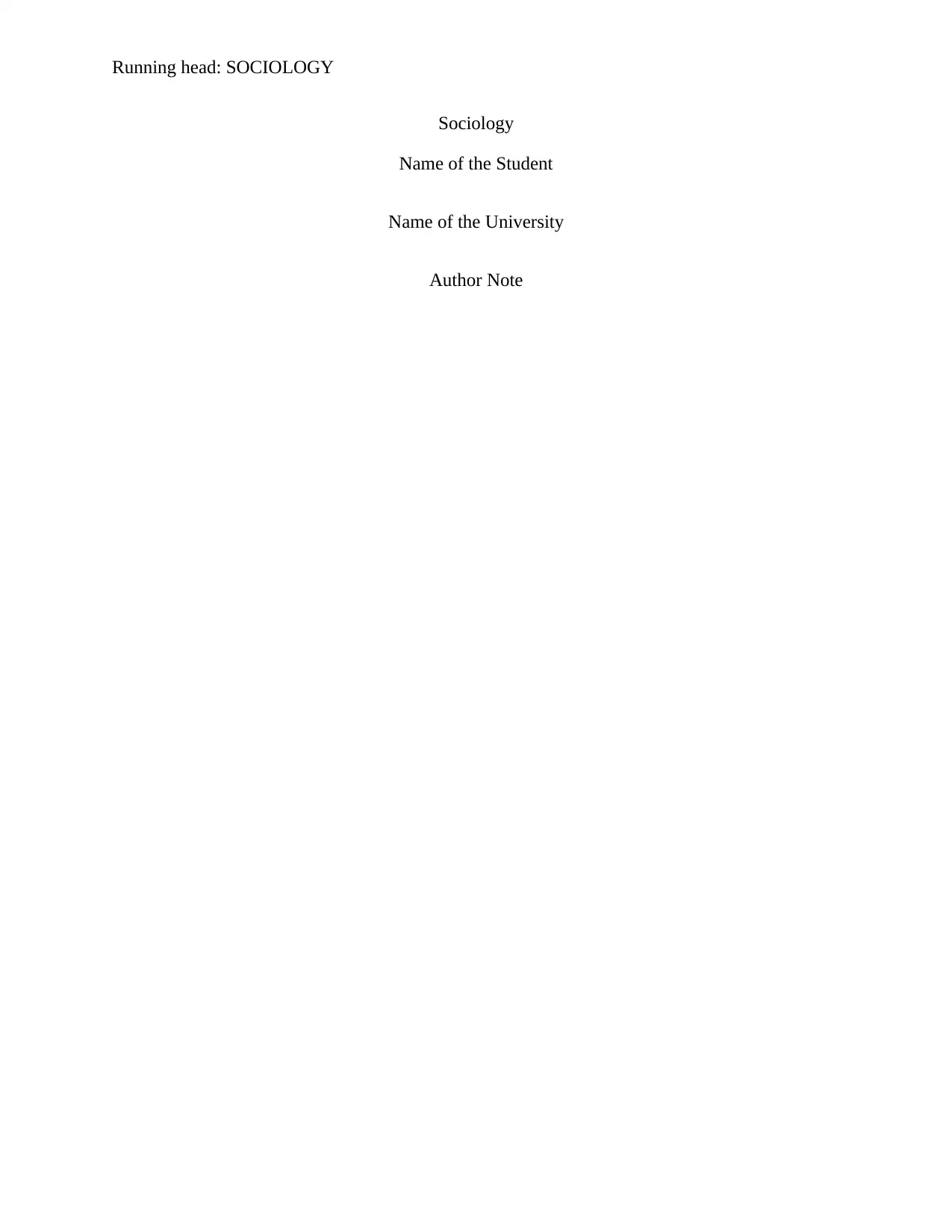
Running head: SOCIOLOGY
Sociology
Name of the Student
Name of the University
Author Note
Sociology
Name of the Student
Name of the University
Author Note
Paraphrase This Document
Need a fresh take? Get an instant paraphrase of this document with our AI Paraphraser
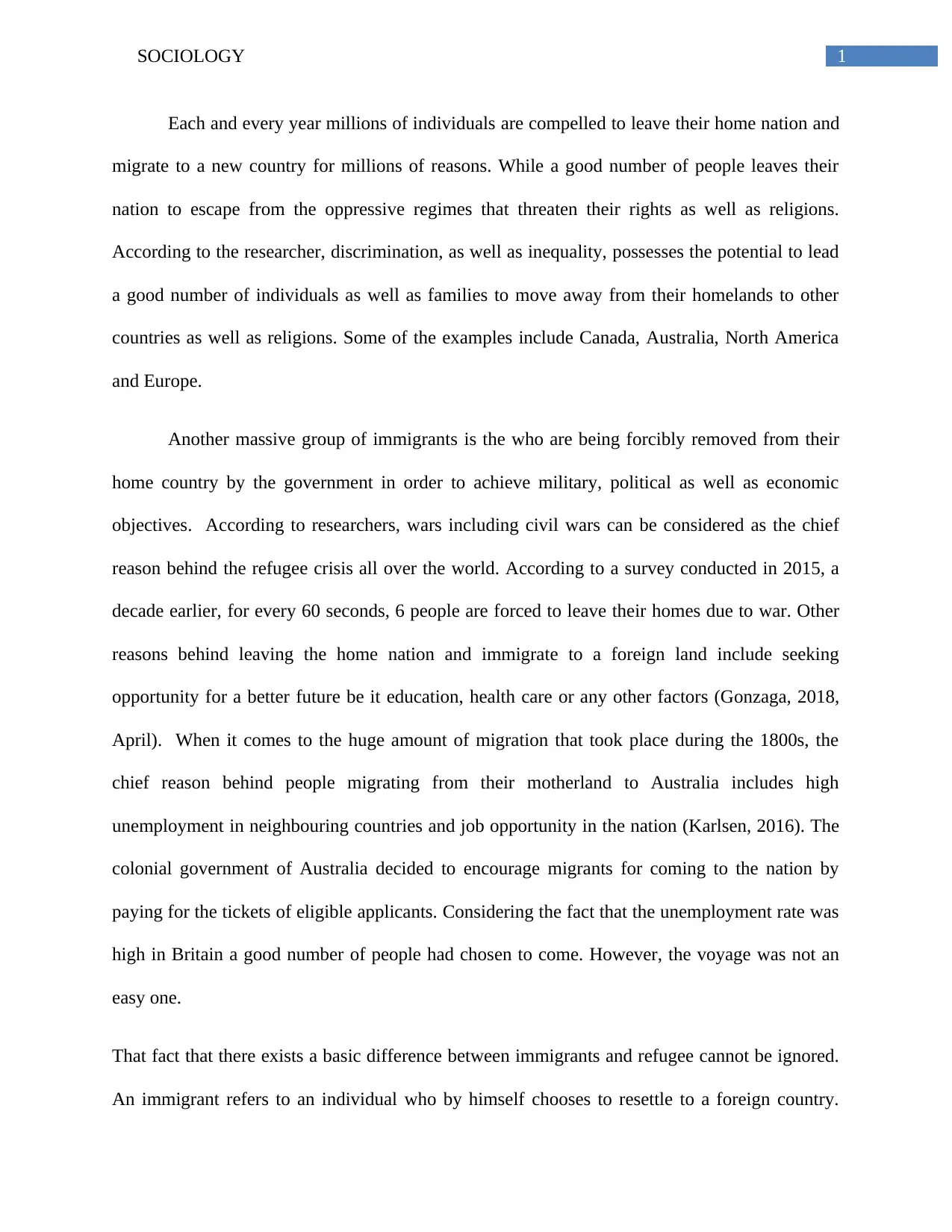
1SOCIOLOGY
Each and every year millions of individuals are compelled to leave their home nation and
migrate to a new country for millions of reasons. While a good number of people leaves their
nation to escape from the oppressive regimes that threaten their rights as well as religions.
According to the researcher, discrimination, as well as inequality, possesses the potential to lead
a good number of individuals as well as families to move away from their homelands to other
countries as well as religions. Some of the examples include Canada, Australia, North America
and Europe.
Another massive group of immigrants is the who are being forcibly removed from their
home country by the government in order to achieve military, political as well as economic
objectives. According to researchers, wars including civil wars can be considered as the chief
reason behind the refugee crisis all over the world. According to a survey conducted in 2015, a
decade earlier, for every 60 seconds, 6 people are forced to leave their homes due to war. Other
reasons behind leaving the home nation and immigrate to a foreign land include seeking
opportunity for a better future be it education, health care or any other factors (Gonzaga, 2018,
April). When it comes to the huge amount of migration that took place during the 1800s, the
chief reason behind people migrating from their motherland to Australia includes high
unemployment in neighbouring countries and job opportunity in the nation (Karlsen, 2016). The
colonial government of Australia decided to encourage migrants for coming to the nation by
paying for the tickets of eligible applicants. Considering the fact that the unemployment rate was
high in Britain a good number of people had chosen to come. However, the voyage was not an
easy one.
That fact that there exists a basic difference between immigrants and refugee cannot be ignored.
An immigrant refers to an individual who by himself chooses to resettle to a foreign country.
Each and every year millions of individuals are compelled to leave their home nation and
migrate to a new country for millions of reasons. While a good number of people leaves their
nation to escape from the oppressive regimes that threaten their rights as well as religions.
According to the researcher, discrimination, as well as inequality, possesses the potential to lead
a good number of individuals as well as families to move away from their homelands to other
countries as well as religions. Some of the examples include Canada, Australia, North America
and Europe.
Another massive group of immigrants is the who are being forcibly removed from their
home country by the government in order to achieve military, political as well as economic
objectives. According to researchers, wars including civil wars can be considered as the chief
reason behind the refugee crisis all over the world. According to a survey conducted in 2015, a
decade earlier, for every 60 seconds, 6 people are forced to leave their homes due to war. Other
reasons behind leaving the home nation and immigrate to a foreign land include seeking
opportunity for a better future be it education, health care or any other factors (Gonzaga, 2018,
April). When it comes to the huge amount of migration that took place during the 1800s, the
chief reason behind people migrating from their motherland to Australia includes high
unemployment in neighbouring countries and job opportunity in the nation (Karlsen, 2016). The
colonial government of Australia decided to encourage migrants for coming to the nation by
paying for the tickets of eligible applicants. Considering the fact that the unemployment rate was
high in Britain a good number of people had chosen to come. However, the voyage was not an
easy one.
That fact that there exists a basic difference between immigrants and refugee cannot be ignored.
An immigrant refers to an individual who by himself chooses to resettle to a foreign country.

2SOCIOLOGY
Australia has legal prices for the immigrants to see legal residency as well as eventual
citizenship. According to researchers, the chief reason behind moving from one country to
another as an immigrant is to improve their prospects of an individual as well as his/her family
(Holmes & Castañeda, 2016). When it comes to the concept of Refugees, they can be defined as
individuals who are compelled to move from their home nation to another nation in order to
either save their life or for preserving freedom. Unlike immigrants, refugees are forced to flee
their home country for the above-mentioned reason. In Australia, applicants of refugees need to
prove that if they return to their homeland, they possess the risk of getting injured or killed on
the basis of race, nationality, religion or other factors in order to apply for asylum in Australia.
The number of arrivals of migrants and refugees has been increased almost exponentially from
last decade. According to Refugee Council of Australia (2018), from 2009 to 2010, around
140,610 refugees and migrants were counted were almost 7% (9900) were humanitarian arrival.
The number of arrivals decreased in 2011 and became 127460 where 7.2% (9130) people were
humanitarian. On the next year 2011 to 2012 the arrival increased to 158940 where only 4.8%
(7576) peoples were humanitarian arrival. Within 2012 to 2013 the total 254,734 refugees and
migrants were counted were almost 7.2% (146,321) were humanitarian arrivals. In recent days
(2012 to 2013) the two major migrants and refugees settlement areas are New South Wales
(32.8% of total entrance) and Victoria (33.9% of total entrance). In last decade these are the two
major areas that hold almost 60% settlements including both migrants and refugees. Less than
one third of refugees in the mentioned nation’s humanitarian program are resettled from UNHCR
(Refugee Council of Australia, 2018). In 2018, approximately 4,940 of the 7,909 Refugee visas
were settled to individuals not referred by the UNHCR.
Australia has legal prices for the immigrants to see legal residency as well as eventual
citizenship. According to researchers, the chief reason behind moving from one country to
another as an immigrant is to improve their prospects of an individual as well as his/her family
(Holmes & Castañeda, 2016). When it comes to the concept of Refugees, they can be defined as
individuals who are compelled to move from their home nation to another nation in order to
either save their life or for preserving freedom. Unlike immigrants, refugees are forced to flee
their home country for the above-mentioned reason. In Australia, applicants of refugees need to
prove that if they return to their homeland, they possess the risk of getting injured or killed on
the basis of race, nationality, religion or other factors in order to apply for asylum in Australia.
The number of arrivals of migrants and refugees has been increased almost exponentially from
last decade. According to Refugee Council of Australia (2018), from 2009 to 2010, around
140,610 refugees and migrants were counted were almost 7% (9900) were humanitarian arrival.
The number of arrivals decreased in 2011 and became 127460 where 7.2% (9130) people were
humanitarian. On the next year 2011 to 2012 the arrival increased to 158940 where only 4.8%
(7576) peoples were humanitarian arrival. Within 2012 to 2013 the total 254,734 refugees and
migrants were counted were almost 7.2% (146,321) were humanitarian arrivals. In recent days
(2012 to 2013) the two major migrants and refugees settlement areas are New South Wales
(32.8% of total entrance) and Victoria (33.9% of total entrance). In last decade these are the two
major areas that hold almost 60% settlements including both migrants and refugees. Less than
one third of refugees in the mentioned nation’s humanitarian program are resettled from UNHCR
(Refugee Council of Australia, 2018). In 2018, approximately 4,940 of the 7,909 Refugee visas
were settled to individuals not referred by the UNHCR.
⊘ This is a preview!⊘
Do you want full access?
Subscribe today to unlock all pages.

Trusted by 1+ million students worldwide
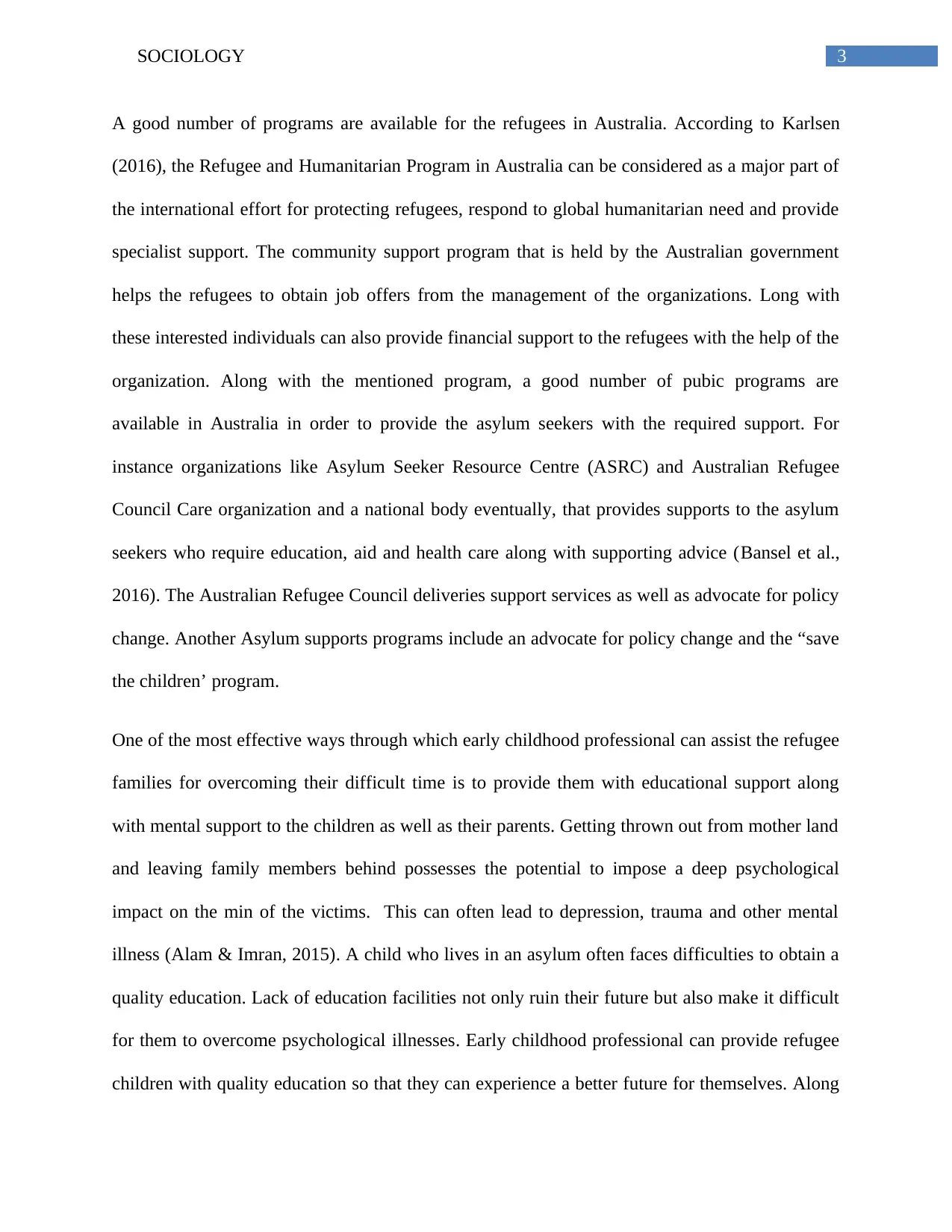
3SOCIOLOGY
A good number of programs are available for the refugees in Australia. According to Karlsen
(2016), the Refugee and Humanitarian Program in Australia can be considered as a major part of
the international effort for protecting refugees, respond to global humanitarian need and provide
specialist support. The community support program that is held by the Australian government
helps the refugees to obtain job offers from the management of the organizations. Long with
these interested individuals can also provide financial support to the refugees with the help of the
organization. Along with the mentioned program, a good number of pubic programs are
available in Australia in order to provide the asylum seekers with the required support. For
instance organizations like Asylum Seeker Resource Centre (ASRC) and Australian Refugee
Council Care organization and a national body eventually, that provides supports to the asylum
seekers who require education, aid and health care along with supporting advice (Bansel et al.,
2016). The Australian Refugee Council deliveries support services as well as advocate for policy
change. Another Asylum supports programs include an advocate for policy change and the “save
the children’ program.
One of the most effective ways through which early childhood professional can assist the refugee
families for overcoming their difficult time is to provide them with educational support along
with mental support to the children as well as their parents. Getting thrown out from mother land
and leaving family members behind possesses the potential to impose a deep psychological
impact on the min of the victims. This can often lead to depression, trauma and other mental
illness (Alam & Imran, 2015). A child who lives in an asylum often faces difficulties to obtain a
quality education. Lack of education facilities not only ruin their future but also make it difficult
for them to overcome psychological illnesses. Early childhood professional can provide refugee
children with quality education so that they can experience a better future for themselves. Along
A good number of programs are available for the refugees in Australia. According to Karlsen
(2016), the Refugee and Humanitarian Program in Australia can be considered as a major part of
the international effort for protecting refugees, respond to global humanitarian need and provide
specialist support. The community support program that is held by the Australian government
helps the refugees to obtain job offers from the management of the organizations. Long with
these interested individuals can also provide financial support to the refugees with the help of the
organization. Along with the mentioned program, a good number of pubic programs are
available in Australia in order to provide the asylum seekers with the required support. For
instance organizations like Asylum Seeker Resource Centre (ASRC) and Australian Refugee
Council Care organization and a national body eventually, that provides supports to the asylum
seekers who require education, aid and health care along with supporting advice (Bansel et al.,
2016). The Australian Refugee Council deliveries support services as well as advocate for policy
change. Another Asylum supports programs include an advocate for policy change and the “save
the children’ program.
One of the most effective ways through which early childhood professional can assist the refugee
families for overcoming their difficult time is to provide them with educational support along
with mental support to the children as well as their parents. Getting thrown out from mother land
and leaving family members behind possesses the potential to impose a deep psychological
impact on the min of the victims. This can often lead to depression, trauma and other mental
illness (Alam & Imran, 2015). A child who lives in an asylum often faces difficulties to obtain a
quality education. Lack of education facilities not only ruin their future but also make it difficult
for them to overcome psychological illnesses. Early childhood professional can provide refugee
children with quality education so that they can experience a better future for themselves. Along
Paraphrase This Document
Need a fresh take? Get an instant paraphrase of this document with our AI Paraphraser
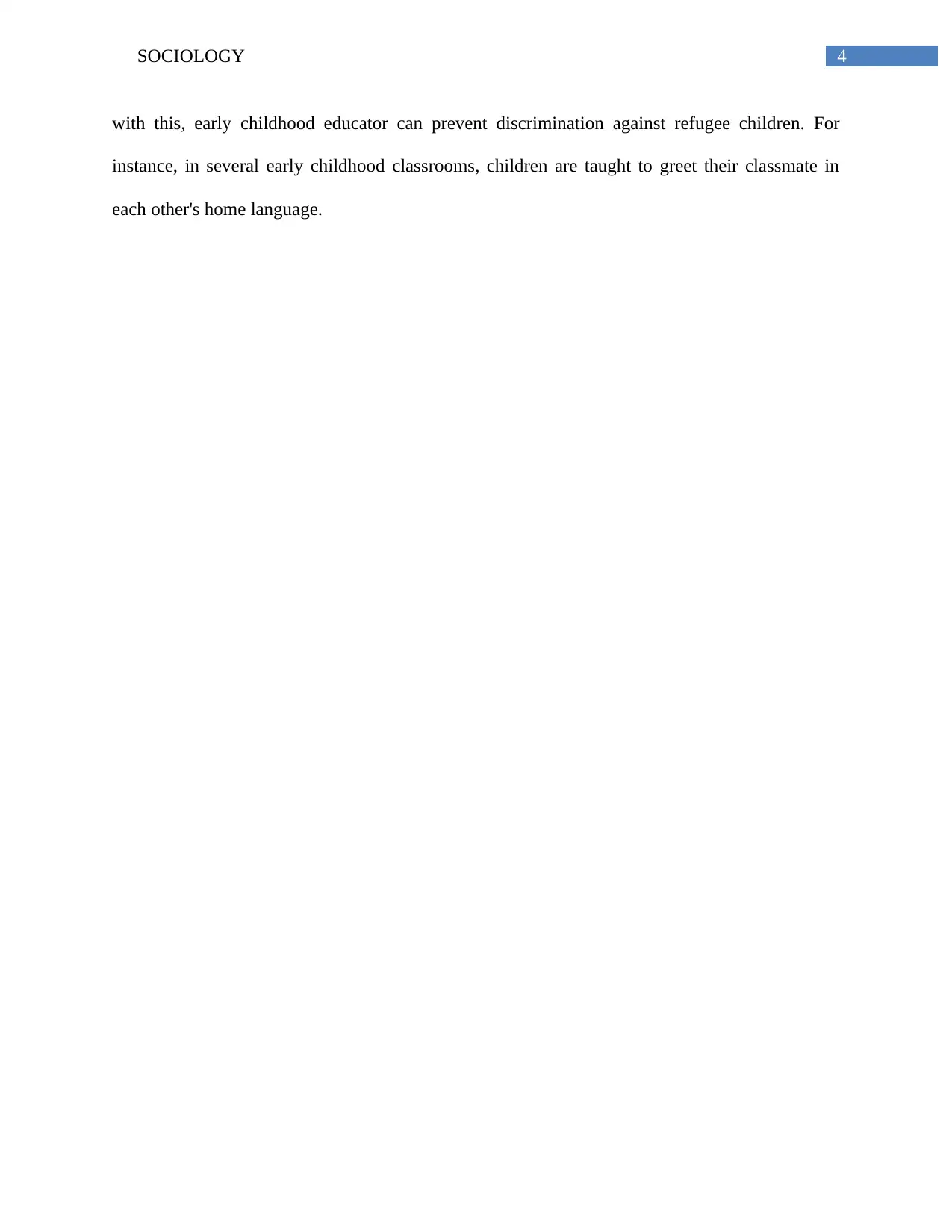
4SOCIOLOGY
with this, early childhood educator can prevent discrimination against refugee children. For
instance, in several early childhood classrooms, children are taught to greet their classmate in
each other's home language.
with this, early childhood educator can prevent discrimination against refugee children. For
instance, in several early childhood classrooms, children are taught to greet their classmate in
each other's home language.
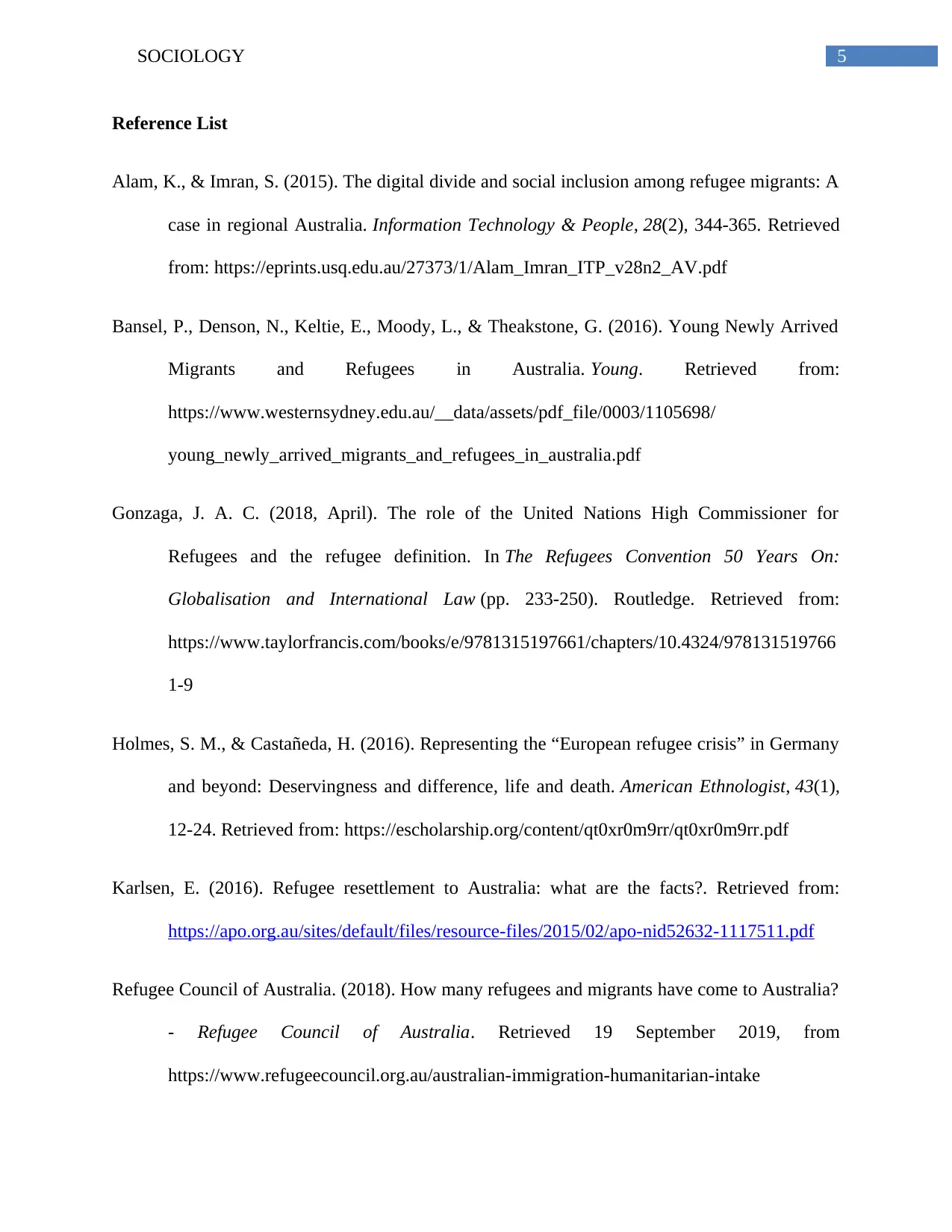
5SOCIOLOGY
Reference List
Alam, K., & Imran, S. (2015). The digital divide and social inclusion among refugee migrants: A
case in regional Australia. Information Technology & People, 28(2), 344-365. Retrieved
from: https://eprints.usq.edu.au/27373/1/Alam_Imran_ITP_v28n2_AV.pdf
Bansel, P., Denson, N., Keltie, E., Moody, L., & Theakstone, G. (2016). Young Newly Arrived
Migrants and Refugees in Australia. Young. Retrieved from:
https://www.westernsydney.edu.au/__data/assets/pdf_file/0003/1105698/
young_newly_arrived_migrants_and_refugees_in_australia.pdf
Gonzaga, J. A. C. (2018, April). The role of the United Nations High Commissioner for
Refugees and the refugee definition. In The Refugees Convention 50 Years On:
Globalisation and International Law (pp. 233-250). Routledge. Retrieved from:
https://www.taylorfrancis.com/books/e/9781315197661/chapters/10.4324/978131519766
1-9
Holmes, S. M., & Castañeda, H. (2016). Representing the “European refugee crisis” in Germany
and beyond: Deservingness and difference, life and death. American Ethnologist, 43(1),
12-24. Retrieved from: https://escholarship.org/content/qt0xr0m9rr/qt0xr0m9rr.pdf
Karlsen, E. (2016). Refugee resettlement to Australia: what are the facts?. Retrieved from:
https://apo.org.au/sites/default/files/resource-files/2015/02/apo-nid52632-1117511.pdf
Refugee Council of Australia. (2018). How many refugees and migrants have come to Australia?
- Refugee Council of Australia. Retrieved 19 September 2019, from
https://www.refugeecouncil.org.au/australian-immigration-humanitarian-intake
Reference List
Alam, K., & Imran, S. (2015). The digital divide and social inclusion among refugee migrants: A
case in regional Australia. Information Technology & People, 28(2), 344-365. Retrieved
from: https://eprints.usq.edu.au/27373/1/Alam_Imran_ITP_v28n2_AV.pdf
Bansel, P., Denson, N., Keltie, E., Moody, L., & Theakstone, G. (2016). Young Newly Arrived
Migrants and Refugees in Australia. Young. Retrieved from:
https://www.westernsydney.edu.au/__data/assets/pdf_file/0003/1105698/
young_newly_arrived_migrants_and_refugees_in_australia.pdf
Gonzaga, J. A. C. (2018, April). The role of the United Nations High Commissioner for
Refugees and the refugee definition. In The Refugees Convention 50 Years On:
Globalisation and International Law (pp. 233-250). Routledge. Retrieved from:
https://www.taylorfrancis.com/books/e/9781315197661/chapters/10.4324/978131519766
1-9
Holmes, S. M., & Castañeda, H. (2016). Representing the “European refugee crisis” in Germany
and beyond: Deservingness and difference, life and death. American Ethnologist, 43(1),
12-24. Retrieved from: https://escholarship.org/content/qt0xr0m9rr/qt0xr0m9rr.pdf
Karlsen, E. (2016). Refugee resettlement to Australia: what are the facts?. Retrieved from:
https://apo.org.au/sites/default/files/resource-files/2015/02/apo-nid52632-1117511.pdf
Refugee Council of Australia. (2018). How many refugees and migrants have come to Australia?
- Refugee Council of Australia. Retrieved 19 September 2019, from
https://www.refugeecouncil.org.au/australian-immigration-humanitarian-intake
⊘ This is a preview!⊘
Do you want full access?
Subscribe today to unlock all pages.

Trusted by 1+ million students worldwide
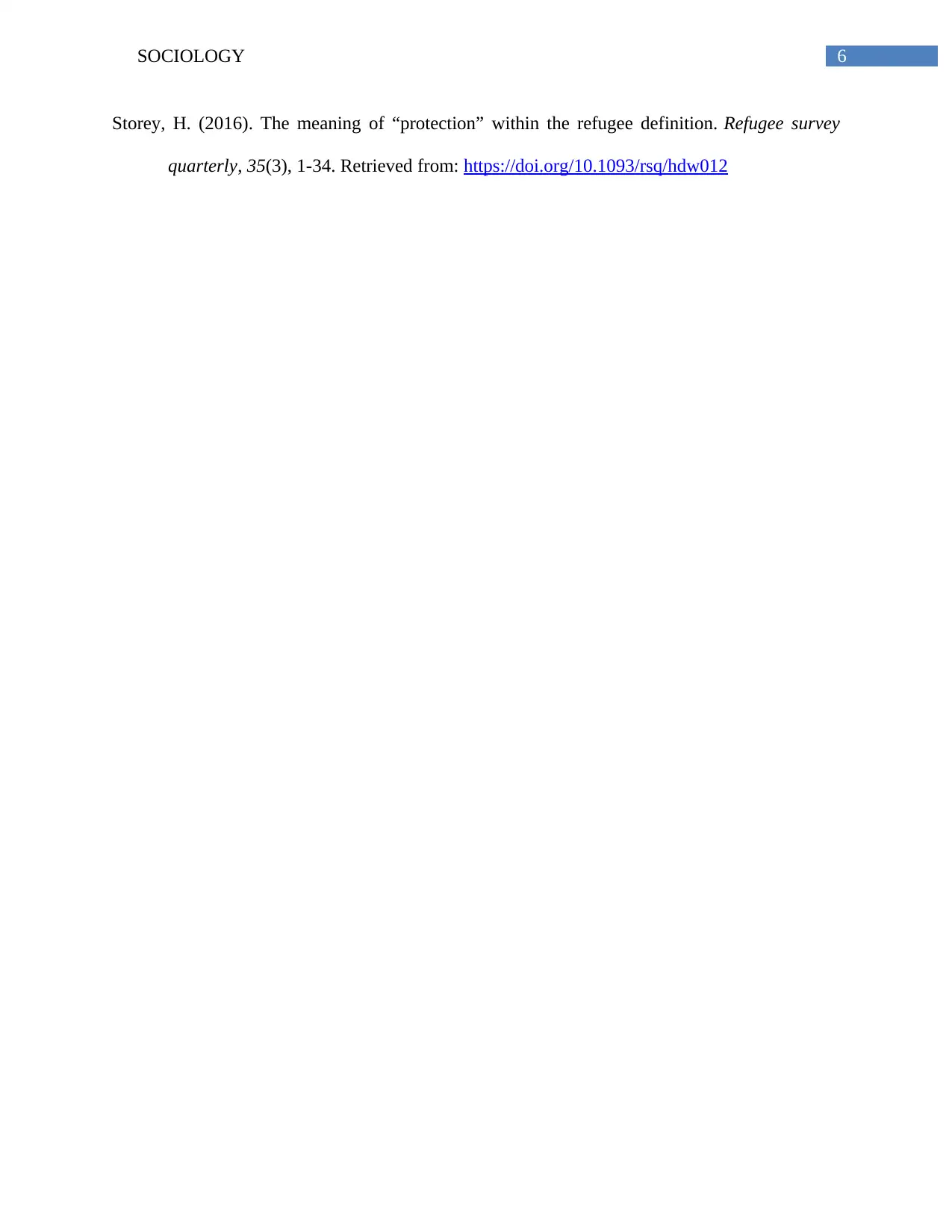
6SOCIOLOGY
Storey, H. (2016). The meaning of “protection” within the refugee definition. Refugee survey
quarterly, 35(3), 1-34. Retrieved from: https://doi.org/10.1093/rsq/hdw012
Storey, H. (2016). The meaning of “protection” within the refugee definition. Refugee survey
quarterly, 35(3), 1-34. Retrieved from: https://doi.org/10.1093/rsq/hdw012
1 out of 7
Related Documents
Your All-in-One AI-Powered Toolkit for Academic Success.
+13062052269
info@desklib.com
Available 24*7 on WhatsApp / Email
![[object Object]](/_next/static/media/star-bottom.7253800d.svg)
Unlock your academic potential
Copyright © 2020–2025 A2Z Services. All Rights Reserved. Developed and managed by ZUCOL.





